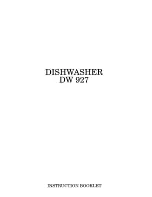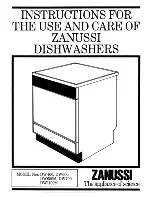
12
Filtration System
Your dishwasher has the latest technology in dishwasher filtration. This filtration system minimizes sound and optimizes water and
energy conservation while providing superior cleaning.
The filter system consists of two parts, an upper filter assembly
and a lower filter.
IMPORTANT:
To avoid damage to dishwasher, do not operate your dishwasher
without filters properly installed. Be sure lower filter is securely in place and
upper filter assembly is locked into place. If upper assembly turns freely, it is not
locked into place.
The filters may need to be cleaned when:
■
Visible objects or soils are on the upper filter assembly.
■
Dishes feel gritty to the touch.
It is very easy to remove and maintain the filters. The chart below shows the recommended cleaning frequency.
RECOMMENDED TIME INTERVAL TO CLEAN YOUR FILTER
Number of Loads Per Week
If you only scrape before
loading*
If you scrape and rinse
before loading
If you wash before loading
8–12
Every 2 months
Every 4 months
Once per year
4–7
Every 4 months
Once per year
Once per year
1–3
Twice per year
Once per year
Once per year
*Scrape excess food into the trash or food disposer prior to loading the dishwasher. We recommend this practice because it will
conserve the water and energy that you would have used to prepare your dishes. This will also save you time and effort.
Very Hard Water
If you have hard water (above 15 grains), clean your filter at least
once per month. Buildup of white residue on your dishwasher
indicates hard water. For tips on removing spots and stains, see
the “Troubleshooting” section.
Filter Removal Instructions
1.
Turn the upper filter assembly a quarter turn
counterclockwise and lift out.
2.
Separate the upper filter assembly by gently pulling apart.
3.
Clean the filters as shown.
Cleaning Instructions
IMPORTANT:
Do not use wire brushes, scouring pads, etc., as
they may damage the filters.
Rinse filter under running water until most soils are removed. If
you have hard-to-remove soils or calcium deposits from hard
water, a soft brush may be required.
Filter Reinstallation Instructions
1.
Noting the previous illustrations, place the lower filter under
the locating tabs in the bottom of the dishwasher, so the
round opening for the upper filter assembly lines up with the
round opening in the bottom of the tub.
2.
Insert the upper filter assembly into the circular opening in
the lower filter.
3.
Slowly rotate the filter clockwise until it drops into place.
Continue to rotate until the filter is locked into place. If the
filter is not fully seated (still turns freely), continue to turn the
filter clockwise until it drops and locks into place.
NOTE:
The upper filter assembly arrow does not have to
align with the arrow in the lower filter as long as the filter is
locked.
IMPORTANT:
To avoid damage to dishwasher, do not operate
your dishwasher without the filters properly installed. Be sure
the lower filter is securely in place and the upper filter assembly
is locked into place. If the upper filter assembly turns freely, it is
not locked into place.
Locating tab
To remove upper filter assembly
P
U
S
H
D
O
W
N
&
T
U
R
N
L
O
C
K
U
N
L
O
C K
LO
C
K
U
NLO
CK
PUSH
DO
W
N
&
T
U
R
N
Locating tab
To replace upper filter assembly
Lower filter
Upper filter
assembly


































